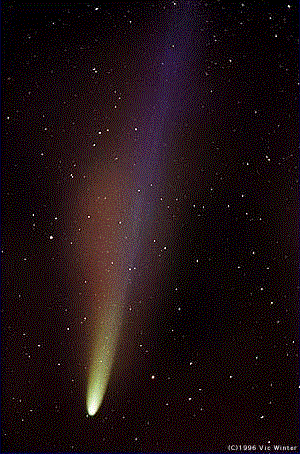Astronomy Picture of the Day
Discover the cosmos!
Each day a different image or photograph of our fascinating universe is
featured, along with a brief explanation written by a professional
astronomer.
May 2, 1996

The Tails of Comet Hyakutake
Credit and Copyright:
Vic
Winter, Courtesy
ICSTARS
Explanation:
What makes comet tails so colorful?
This
photograph of Comet Hyakutake was
taken the night of April 18th and highlights different
components of the tail. The gold
and red tail features are
dust, made predominately of little bits of rock
and carbon. The dust tail shines by reflecting sunlight. Extending past
the dust tail is the comet's ion tail,
shown here glowing in blue. The ion tail is composed mostly of ions of
water, carbon monoxide, and
cyanogen.
The ion tail glows by emitting light
when elections re-combine with electrically charged ions to make uncharged
molecules. The photograph was taken just north of Kansas City, Missouri,
USA.
Latest Comet Hyakutake images:
APOD Hyakutake Archive,
JPL,
Fayetteville
Observer-Times,
NASA's Night of
the Comet,
ICSTARS,
Jerry Lodriguss,
ScienceWeb,
Crni Vrh Obs.,
Tomorrow's picture: The Milky Way and the Southern Cross
| Archive
| Index
| Search
| Glossary
| Education
| About APOD |




Authors & editors:
Robert Nemiroff
(GMU) &
Jerry
Bonnell (USRA).
NASA Technical Rep.:
Sherri
Calvo.
Specific rights apply.
A service of:
LHEA
at
NASA/
GSFC




